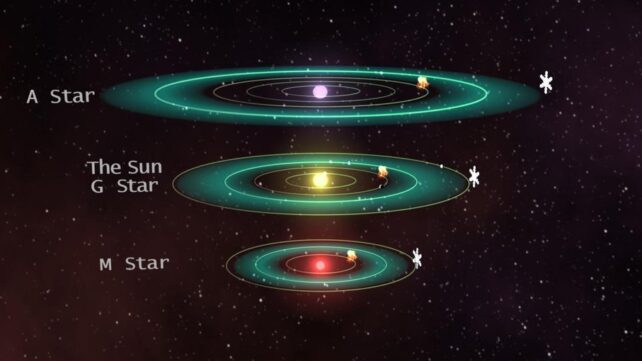The Key to Habitable Alien Worlds Might Lie in Entropy
We are all aware that in order for life to exist on a planet, there are three essential requirements: water, warmth, and food. However, there is another factor known as “entropy” that also plays a crucial role in determining whether a planet can sustain and foster complex life.
Luigi Petraccone, a chemistry researcher at the University of Naples in Italy, has taken a keen interest in planetary entropy. His focus lies in understanding how scientists identify planets that have the potential to support life. In a recently published paper, he delves into the concept of “planetary entropy production” (PEP) and its significance.
A habitable world necessitates the presence of a biosphere teeming with living organisms. All forms of life thrive and expand by utilizing the available resources of water, warmth, and food. Interestingly, entropy manifests within a planet’s biosphere and a relatively high PEP is required.
This high PEP indicates a greater likelihood of complex life systems existing and makes the planet an ideal candidate for exploration. According to Petraccone’s research, the chemical composition of the life forms, whether carbon-based, silicon-based, or composed of another element, is irrelevant. What truly matters is the progression of life towards increased complexity.

What’s Entropy?
Let’s begin by discussing entropy before delving into Petraccone’s paper. In physics, entropy is defined as a thermodynamic quantity that represents the unavailability of a system’s thermal energy for conversion into mechanical work.
According to the second law of thermodynamics, the universe moves in a direction where entropy increases. This concept may seem intricate, so let’s simplify it by considering entropy as a measure of randomness or disorder within a system. An orderly system possesses just enough energy to fulfill its necessary functions.
When a system produces or acquires more energy, it results in a higher level of entropy. Living organisms, for instance, are highly organized and require a continuous input of energy to maintain a state of low entropy. As part of the life process, they generate waste, by-products, and inevitably lose energy. The greater the energy influx and subsequent loss to the surroundings, the more disorderly and random the system becomes. Essentially, its entropy state increases.
In biology, entropy plays a role when examining the systems that contribute to life on a planet. Petraccone explains that the extent of entropy production is directly related to the ability of these systems to dissipate free energy, allowing them to “live,” evolve, and grow in complexity. Generally, a certain threshold of entropy production must be surpassed for the emergence of intricate self-organizing structures. Therefore, entropy production can be seen as the thermodynamic force that propels the emergence and evolution of life.
That brings us to the “planetary entropy production” (PEP) value that can help scientists target likely life-friendly planets.
The most habitable ones will be where life can generate the most entropy. The more complex and dynamic the life forms are, the more entropy they’ll produce and the higher PEP value they maintain. Petraccone proposes that different planets will have more or less of an energy potential, predicting which planets are most likely to be habitable.
Applying Planetary Entropy Production to a Life Search
Determining the location and potential existence of life on a planet is of utmost importance. Initially, it must be situated within the circumstellar habitable zone (CHZ) surrounding its star, where liquid water can be present on the planet’s surface.
The positioning of the planet within the CHZ also plays a significant role. If it is too close to the inner edge, the planet may lose its water due to excessive heating from the star, resulting in a runaway greenhouse effect. On the other hand, if it is closer to the outer edge, it may not be as suitable for supporting life compared to a planet located in the central region of the CHZ. Furthermore, even if a planet is in the ideal part of the zone, it may still face other obstacles in sustaining a biosphere.
Why not explore planets throughout the entire CHZ? This is because there are thermodynamic disparities between the inner and outer edges of the CHZ. The inner edge provides more favorable conditions for the development of complex biospheres.
Both the Planetary Energy Potential (PEP) and the available free energy for Earth-like planets increase with the temperature of the star. Taking this into account, Petraccone and his team utilized their calculations to assess the PEP and free energy for a selected group of proposed habitable planets.
Scientists also need to determine the upper limit of a planet’s PEP value and the corresponding free energy it receives based on the temperature of the star and the planet’s orbital parameters.
For instance, Petraccone explains that only Earth-like planets within the CHZ of G and F stars can possess a PEP value higher than that of Earth (which serves as a reference). This implies that they are more likely to support life compared to planets located in other regions of the habitable zone.

Why Use PEP as a Rationale for Planetary Habitability?
Interestingly, among the recently proposed habitable exoplanets, the “Hycean” worlds stand out as the most thermodynamically favorable candidates. These planets possess hydrogen-rich atmospheres and liquid water oceans, making them highly suitable for sustaining life. Our own planet serves as a valuable reference point, offering a roadmap for evaluating these exoplanets.
Scientists are currently investigating the optimal balance between land and oceans for a habitable world, using Earth as a comparative model. Earth’s position near the inner edge of the Sun’s habitable zone (CHZ) grants it a higher Potential Entropy Production (PEP) value, which is crucial for supporting life.
By assuming that Earth’s PEP value is a prerequisite for life, planetary scientists can establish an “entropic habitable zone” (EHZ). This zone encompasses the range of distances from a star where a planet possesses both liquid water and a high PEP value.
When applying these criteria to other planets, it becomes evident that worlds orbiting low-mass stars would not develop a sufficiently high EHZ to sustain life. Similarly, M and K stars would not meet the necessary conditions. However, a fraction of planets orbiting F and G stars could fortuitously fall within the favorable “zone” and potentially foster the emergence of life.
Selecting Those Possible Habitable Planets
In recent times, there has been a significant increase in the discovery of exoplanets orbiting nearby stars. However, examining each of these planets in the search for signs of life is an incredibly challenging task. Therefore, scientists require effective criteria to prioritize which planets should be studied further.
One such criterion that appears to be promising is the measurement of entropy production. This factor serves as a reliable indicator of a planet’s potential to support life and also provides insights into the complexity of that life.
What makes this approach even more intriguing is that it offers several advantages. Firstly, it does not rely on assumptions about the atmospheric conditions of a given planet. Additionally, it does not draw any conclusions about the chemical foundations of the living systems present on that planet.
Instead, these criteria offer scientists a method to evaluate and rank exoplanets as they sift through the vast number of discoveries, enabling them to identify the most promising candidates for further study.
This article is republished from sciencealert under a Creative Commons license. Read the original article.
Do not forget to share your opinion with us to provide you with the best posts !





0 Comments